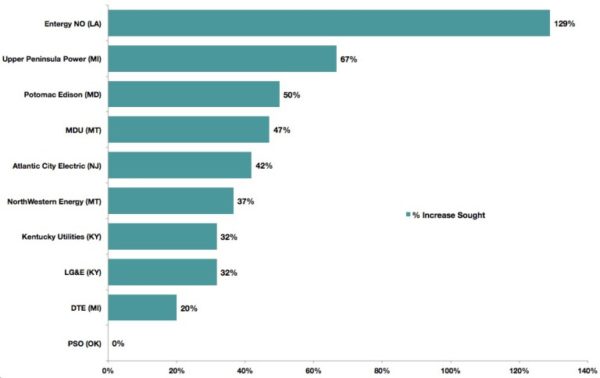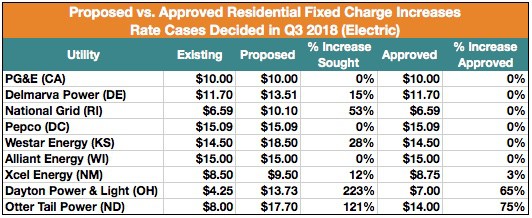Utilities have generally responded to the existential threat that net-metered solar presents to their business model in similar ways. As seeking to have regulators cap or scrap the policy has shown mixed success, they have consistently turned to increased fixed charges and/or demand charges to claw back more of the revenue that they fear that they could lose in the future.
Demand charges on residential customers have in almost all cases been rejected, the unregulated Salt River Power co-op in Arizona and Eversource in Massachusetts being significant exceptions. As such, increased fixed charges have become among the most popular way to attempt to both increase their revenue from customers who have adopted rooftop solar and/or kill distributed solar markets outright.
EQ Research’s Q3 2018 General Rate Case Update underscores how prevalent this approach is. Of the 10 utilities in seven states filing rate cases during the third quarter, nine sought fixed charge increases of at least 20%, and the average was 45%.

The most egregious was Entergy New Orleans (ENO) in Louisiana. Apparently not shamed by having been exposed hiring actors through a contractor to fake public support for a gas plant (which is still being built), ENO is seeking to more than double its fixed charge on residential customers in city from $8.07 to $18.48.
In Michigan, utilities DTE and Upper Peninsula Power both filed rate cases that include both fixed charge increases as well as new tariff structures to replace net metering, as part of the scrapping of the policy that utilities requested and were granted by Michigan regulators.
Slowly ratcheting up fixed charges
While many utilities continue to seek to increase these charges, they are mostly failing. Of the nine rate cases decided during the third quarter, EQ says that seven resulted in either no or minimal fixed charge increases.
Those that did succeed were fairly underwhelming. While Dayton Power & Light was able to achieve a higher fixed charge, the result of $7.00 per month is certainly not the highest that EQ Research has seen. The only real success was North Dakota approving Otter Tail Power’s increase in its fixed charge to $14.00 per month, which EQ notes was less than the $17.70 requested by the utility.
This is not for want of trying. The various utilities which had asked for increases sought anywhere from 15% to 223%, and only one (Xcel Energy) asked for a fixed charge of less than $10 per month.

The reasons that utilities are being turned down are complex. While utilities often make dubious claims about other customers subsidizing net metered solar, this canard has been widely disproven. The less flattering truth is that utilities are in danger of losing revenue, due to widespread customer adoption of distributed generation. However, given the low penetrations of customer-sited solar in nearly all regions it is clear that utilities’ concerns are much more about the future than the present.
Meanwhile, such increases in fixed charges are not only unpopular with the solar industry, but also with proponents of energy efficiency and advocates for low-income consumers, who point out that such charges are regressive as they undermine the economic incentive for efficiency and force a higher-per kilowatt cost on those who use less electricity, which often includes those on a fixed income.
But if utilities are losing these battles, they are still making progress. The general direction of fixed charges is going up, not down, and by continually asking for fixed charge increases, utilities are slowly ratcheting up such charges across the nation.
To learn more about the rate cases that are either recently decided or currently underway, or for those of you who are looking to procrastinate from getting back to work, EQ Research has offered an interactive map or rate cases on its website.
This content is protected by copyright and may not be reused. If you want to cooperate with us and would like to reuse some of our content, please contact: editors@pv-magazine.com.








By submitting this form you agree to pv magazine using your data for the purposes of publishing your comment.
Your personal data will only be disclosed or otherwise transmitted to third parties for the purposes of spam filtering or if this is necessary for technical maintenance of the website. Any other transfer to third parties will not take place unless this is justified on the basis of applicable data protection regulations or if pv magazine is legally obliged to do so.
You may revoke this consent at any time with effect for the future, in which case your personal data will be deleted immediately. Otherwise, your data will be deleted if pv magazine has processed your request or the purpose of data storage is fulfilled.
Further information on data privacy can be found in our Data Protection Policy.